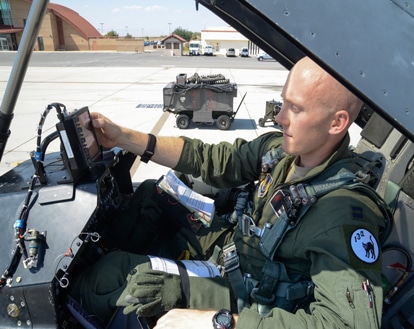
- The SPACE JAM system utilizes an algorithm that injects realistic GPS jamming effects directly into an aircraft’s navigation system. (Image: Rebecca Amber / U.S. Air Force)
A new jamming simulation project being tested by U.S. Air Force students may lead to better training methods and emergency protocols to combat Global Positioning System (GPS) disruption.
Originally designed for military applications during the Cold War in the 1960s, GPS technology is considered an integral part of the daily operations of the U.S. Air Force today, relied on in variety of applications such as navigation, target tracking, missile and projectile guidance, search and rescue and reconnaissance. However, with the widespread development of jamming devices designed to disrupt GPS and other similar systems comes the increasing possibility that these vital guidance systems could rendered unusable during a critical moment, severely handicapping aircraft. To prepare for this possibility, the Air Force is reportedly turning to new research endeavors and training methods.
The Simulated Programmable Aircraft-Embedded Jammer (SPACE JAM) is one such project. Created by Capt. David Levene, an F-15E Weapon Systems Officer (WSO) at the U.S. Air Force Test Pilot School as part of his master’s thesis project, the system utilizes an algorithm that injects realistic GPS jamming effects directly into an aircraft’s navigation system. The hardware for SPACE JAM resides inside a modified AE-4 antenna electronics unit, which already exists in many military aircraft, including the TPS F-16D aircraft in use for the project. A custom software interface, Control Monitoring and Debugging of SPACE JAM (CMDoS), is used to control the various jamming scenarios from the cockpit, including the locations of the jammers and signal parameters such as bandwidth, frequency, and power.
The modified AE-4 antenna electronics unit also houses a secondary, MEMS-grade inertial navigation system that receives the GPS signal upstream from the jamming and is therefore not affected, enabling researchers to see the effects of the jammers.
“The jammers are simulated, but the jamming is real,” Levene said. “It’s really jamming your aircraft’s system, based on the effects of a configurable laydown of simulated jammers.” The test system enables jamming simulations to be loaded and flown at any time, removing cost, space and scheduling restrictions present in traditional GPS jamming exercises.
Eight flights on an F-16 have been scheduled for the purpose of testing the new system. The first flight took place Sept. 10 and evaluated the durability of the hardware in a high-G environment.
“The testing we’re doing now has never been done before,” said Levene. “My hope for the future is that every military aircraft will include a navigation system that can be jammed for training purposes.”






